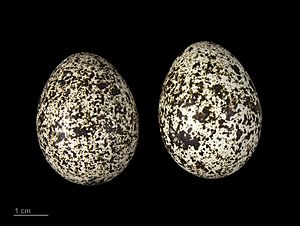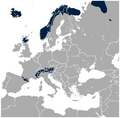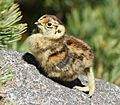Rock ptarmigan facts for kids
The rock ptarmigan (say "TAR-mi-gan") is a special bird that lives in cold, snowy places. It's a type of grouse, which are birds that usually live on the ground. You might hear it called just "ptarmigan" in places like the UK and Canada. In Canada, it's a very important bird! It's the official bird for the territory of Nunavut and the official game bird for Newfoundland and Labrador.
In the United States, some people call it the "snow chicken." And in Japan, it has a cool name: raichō (雷鳥), which means "thunder bird." It's the official bird for three Japanese areas: Gifu, Nagano, and Toyama. The rock ptarmigan is also a protected animal across Japan.
Contents
About the Rock Ptarmigan
The rock ptarmigan is a medium-sized bird. It is known for its amazing ability to change its feather colors. This helps it blend in with its surroundings. This bird is part of the Galliformes group. These are heavy-bodied, ground-feeding birds.
What It Looks Like
Rock ptarmigans are famous for their feathers. They change color with the seasons!
- In winter, they are mostly white. This helps them hide in the snow.
- In spring and summer, their feathers turn brown and gray. This helps them blend in with rocks and plants.
This color change is called seasonal camouflage. It helps them stay safe from predators. Both male and female birds change colors. Males often have a red patch above their eyes.
Where They Live
Rock ptarmigans live in cold, northern parts of the world. You can find them in places like:
- The Arctic regions
- High up in mountains, like the Alps in Europe
- In North America, including Canada and Alaska
- In parts of Asia, like Japan and Siberia
They prefer rocky, open areas above the tree line. This means they live where there are no tall trees. They like places with low-growing plants and shrubs.
What They Eat
Rock ptarmigans are herbivores. This means they eat plants. Their diet changes with the seasons.
- In winter, they mostly eat buds, twigs, and catkins from willow and birch trees. They can dig through snow to find food.
- In summer, they eat berries, leaves, flowers, and seeds. They also eat insects sometimes, especially when they are young.
They have a special digestive system. This helps them get nutrients from tough plant material.
How They Survive the Cold
These birds are built for cold weather. They have several cool adaptations:
- Feathered feet: Their feet are covered in feathers. This acts like snowshoes, helping them walk on snow. It also keeps their feet warm.
- Thick feathers: They have very dense feathers. These feathers trap air close to their body. This creates a warm layer, like a winter coat.
- Burrowing: In very cold or windy conditions, they can burrow into the snow. This creates a warm, sheltered space. It protects them from harsh weather.
Reproduction and Life Cycle
Rock ptarmigans usually start breeding in late spring or early summer. This is when the snow begins to melt.
Nesting and Eggs
The female bird builds a simple nest on the ground. It's often hidden among rocks or low plants. She lays about 6 to 10 eggs. The eggs are usually pale yellow or brown with dark spots. This helps them blend in with the ground. The female does most of the incubation. This means she sits on the eggs to keep them warm. It takes about three weeks for the eggs to hatch.
Chicks and Growing Up
When the chicks hatch, they are covered in soft down feathers. They can leave the nest very soon after hatching. They follow their mother to find food. The mother protects them from predators. The chicks grow quickly. They learn to fly within a few weeks. By the end of summer, they are almost fully grown. They will be ready to face their first winter.
Images for kids
-
Distribution in Europe
-
Distribution in North America
-
Male rock ptarmigan (L. m. islandorum) in winter plumage in Iceland
-
Male rock ptarmigan (L. m. japonicum) in summer plumage on Mount Tsubakuro, Japan
-
Female rock ptarmigan (L. m. millaisi) in summer plumage near Torridon, Scotland
-
Rock ptarmigan (L. m. millaisi) pair (♂ left) in winter plumage near Glen Coe, Scotland
-
L. muta eggs
See also
 In Spanish: Perdiz nival para niños
In Spanish: Perdiz nival para niños













